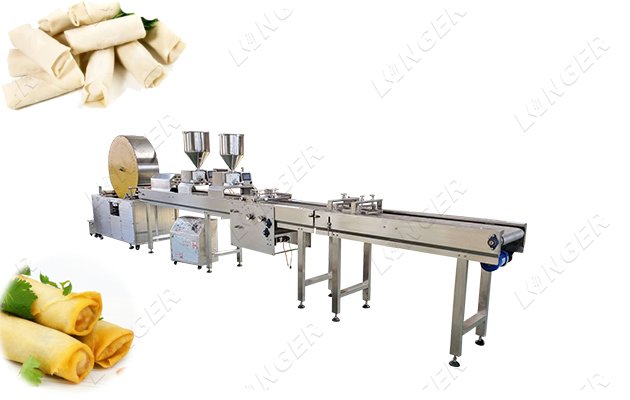Automatic Spring Roll Machine Price
2024-01-29
In the culinary world, spring rolls are beloved for their crispy exterior and flavorful fillings, making them a staple in asian cuisine and beyond. As the demand for these delectable snacks continues to rise, many food businesses are looking for ways to streamline their production processes. One solution gaining traction is the adoption of automatic spring roll production lines. But what is the automatic spring roll machine price?
The rise of automatic spring roll production lines
Automatic spring roll production lines offer a range of benefits that traditional manual production methods simply cannot match. These systems are designed to efficiently handle large volumes of ingredients, streamline the assembly process, and ensure consistency in product quality. By automating repetitive tasks such as wrapping and folding, businesses can significantly increase their output while reducing labor costs and minimizing the risk of errors.

Understanding the costs
Investing in an automatic spring roll production line entails several upfront costs, including:
Equipment: The core component of any automatic production line is the machinery itself. Prices can vary depending on factors such as capacity, features, and manufacturer. A basic system may start at several thousand dollars, while more advanced models with higher capacities can range into the hundreds of thousands.
Installation and setup: Proper installation and setup are crucial to the efficient operation of the production line. Depending on the complexity of the system, installation costs may include expenses for transportation, onsite assembly, and training.
Maintenance and servicing: Like any machinery, automatic production lines require regular maintenance to ensure optimal performance and longevity. Budgeting for ongoing maintenance costs, including spare parts and servicing, is essential.
Operational expenses: Running an automatic production line incurs operational expenses such as electricity, water, and raw materials. While these costs can vary depending on factors like production volume and energy efficiency, they should be factored into the overall cost analysis.
Assessing the benefits
While the initial investment in an automatic spring roll production line may seem substantial, the long-term benefits can far outweigh the costs:
Increased efficiency: Automatic production lines can produce spring rolls at a much faster rate than manual labor, leading to higher output levels and shorter production cycles.
Consistent quality: By standardizing the production process, automatic systems ensure consistency in product quality, size, and appearance, meeting the expectations of consumers and reducing waste due to rejects.
Labor savings: Automating repetitive tasks reduces the need for manual labor, allowing businesses to reallocate resources to other areas of operations or to scale their production without proportional increases in staffing costs.
Improved safety and hygiene: Modern production lines are designed with food safety standards in mind, minimizing the risk of contamination and ensuring compliance with regulatory requirements.
While the decision to invest in an automatic spring roll production line requires careful consideration of costs and benefits, many businesses find that the advantages outweigh the initial expenditure. By increasing efficiency, ensuring consistent quality, and reducing labor costs, these systems offer a compelling solution for food manufacturers looking to meet the growing demand for spring rolls in a competitive market. As technology continues to advance, the future of spring roll production looks increasingly automated.
The rise of automatic spring roll production lines
Automatic spring roll production lines offer a range of benefits that traditional manual production methods simply cannot match. These systems are designed to efficiently handle large volumes of ingredients, streamline the assembly process, and ensure consistency in product quality. By automating repetitive tasks such as wrapping and folding, businesses can significantly increase their output while reducing labor costs and minimizing the risk of errors.

Understanding the costs
Investing in an automatic spring roll production line entails several upfront costs, including:
Equipment: The core component of any automatic production line is the machinery itself. Prices can vary depending on factors such as capacity, features, and manufacturer. A basic system may start at several thousand dollars, while more advanced models with higher capacities can range into the hundreds of thousands.
Installation and setup: Proper installation and setup are crucial to the efficient operation of the production line. Depending on the complexity of the system, installation costs may include expenses for transportation, onsite assembly, and training.
Maintenance and servicing: Like any machinery, automatic production lines require regular maintenance to ensure optimal performance and longevity. Budgeting for ongoing maintenance costs, including spare parts and servicing, is essential.
Operational expenses: Running an automatic production line incurs operational expenses such as electricity, water, and raw materials. While these costs can vary depending on factors like production volume and energy efficiency, they should be factored into the overall cost analysis.
Assessing the benefits
While the initial investment in an automatic spring roll production line may seem substantial, the long-term benefits can far outweigh the costs:
Increased efficiency: Automatic production lines can produce spring rolls at a much faster rate than manual labor, leading to higher output levels and shorter production cycles.
Consistent quality: By standardizing the production process, automatic systems ensure consistency in product quality, size, and appearance, meeting the expectations of consumers and reducing waste due to rejects.
Labor savings: Automating repetitive tasks reduces the need for manual labor, allowing businesses to reallocate resources to other areas of operations or to scale their production without proportional increases in staffing costs.
Improved safety and hygiene: Modern production lines are designed with food safety standards in mind, minimizing the risk of contamination and ensuring compliance with regulatory requirements.
While the decision to invest in an automatic spring roll production line requires careful consideration of costs and benefits, many businesses find that the advantages outweigh the initial expenditure. By increasing efficiency, ensuring consistent quality, and reducing labor costs, these systems offer a compelling solution for food manufacturers looking to meet the growing demand for spring rolls in a competitive market. As technology continues to advance, the future of spring roll production looks increasingly automated.



 Message
Message